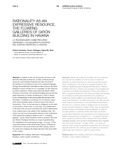Mostrar o rexistro simple do ítem
La racionalidad como recurso expresivo. Las “galerías flotantes” del Edificio Girón en La Habana.
| dc.contributor.author | Pedrós Fernández, Óscar | |
| dc.contributor.author | Rodríguez Cajaraville, Sara | |
| dc.date.accessioned | 2024-03-19T15:24:23Z | |
| dc.date.available | 2024-03-19T15:24:23Z | |
| dc.date.issued | 2022-03 | |
| dc.identifier.citation | PEDRÓS FERNÁNDEZ, Ó., RODRÍGUEZ CAJARAVILLE, S. “Rationality as an expressive resource. The floating galleries of Girón Building in Havana / La racionalidad como recurso expresivo. Las galerías flotantes del Edificio Girón en La Habana”. X Congreso Internacional de Arquitectura Blanca (CIAB X). Valencia, 23-25/03/2022. Valencia: Universitat Politècnica de València, pp. 298-309. ISBN: 978-84-9048-358-9. ISSN: 2695-7884. DOI: https://doi.org/10.4995/CIAB10.2022.13997 | es_ES |
| dc.identifier.isbn | 978-84-9048-358-9 | |
| dc.identifier.issn | 2695-7884 | |
| dc.identifier.uri | http://hdl.handle.net/2183/35932 | |
| dc.description.abstract | [Abstract] In addition to the use of exposed concrete as the leitmotif of Brutalist architecture, another of the expressive resources used relatively frequently has been the exterior formalisation of circulations as part of its sculptural language. Among the architectures that relied on this resource, the Girón Building in Havana stands out as a paradigm of Latin American brutalist architecture. Fifteen years before Bo Bardi’s SESC Pompeia in Sao Paulo, this residential building became the fi rst great experiment in modern architecture in Cuba in relation to the modernisation of the country after the triumph of the Revolution. A building as pioneering as it is unknown, about which documentation does not abound due to the Island’s hermeticism. Thus, its visit becomes as obligatory as the need to document it, draw it and, in some way, try to perpetuate it in the face of the corrosion and advanced state of deterioration it has suff ered due to the salinity of the Caribbean Sea. This article uses the most characteristic element of the architecture of the apartment building at Malecón and F - its fl oating galleries - by the Cuban architects Antonio Quintana Simonetti and Alberto Rodríguez Surribas as a way of apprehending this magnifi cent work and paying homage - in a way - to the utopia and optimism that characterised Cuban architectural environment in the second half of the 20th century, while at the same time analyzing the design decisions that were made in this context. | es_ES |
| dc.description.abstract | [Resumen] Además del empleo de hormigón visto como leitmotiv de la arquitectura brutalista, otro de los recursos expresivos utilizados con relativa frecuencia ha sido la formalización exterior de las circulaciones como parte de su lenguaje escultórico. De entre las arquitecturas que se apoyaron en ese recurso, destaca el Edificio Girón de La Habana, que se yergue como paradigma de la arquitectura brutalista latinoamericana. Quince años anterior al SESC Pompeia de Bo Bardi en Sao Paulo, este edificio de viviendas se convirtió en el primer gran experimento de la arquitectura moderna en Cuba en relación a la modernización del país tras el triunfo de la Revolución. Un edificio tan pionero como desconocido, sobre el que la documentación no abunda debido al hermetismo de la Isla. Así, su visita se vuelve tan obligada como la necesidad de documentarlo, dibujarlo y, de algún modo, tratar de perpetuarlo ante la corrosión y el avanzado estado de deterioro en el que se encuentra debido a la salinidad del Mar del Caribe. El presente artículo utiliza el elemento más característico de la arquitectura del Edificio de apartamentos en Malecón y F —sus galerías flotantes—, de los arquitectos cubanos Antonio Quintana Simonetti y Alberto Rodríguez Surribas como una forma de aprehender esta magnífica obra y de rendir homenaje —de algún modo— a la utopía y el optimismo que inundaron el ambiente arquitectónico de Cuba en la segunda mitad del s.XX, al tiempo que se objetivan las decisiones proyectuales que se llevaron a cabo en aquel contexto. | es_ES |
| dc.language.iso | eng | es_ES |
| dc.publisher | Universitat Politècnica de València | es_ES |
| dc.relation.uri | https://doi.org/10.4995/CIAB10.2022.13997 | es_ES |
| dc.rights | Atribución-NoComercial-CompartirIgual 3.0 España | es_ES |
| dc.rights.uri | http://creativecommons.org/licenses/by-nc-sa/3.0/es/ | * |
| dc.subject | Girón building | es_ES |
| dc.subject | Rationalism | es_ES |
| dc.subject | Floating gallery | es_ES |
| dc.subject | Brutalism | es_ES |
| dc.subject | Cuban modern architecture | es_ES |
| dc.subject | Brutalismo | es_ES |
| dc.subject | Edificio Girón | es_ES |
| dc.subject | Arquitectura moderna en Cuba | es_ES |
| dc.subject | Galerías flotantes | es_ES |
| dc.title | La racionalidad como recurso expresivo. Las “galerías flotantes” del Edificio Girón en La Habana. | es_ES |
| dc.title.alternative | Rationality as an expressive resource. The floating galleries of Girón Building in Havana | es_ES |
| dc.type | info:eu-repo/semantics/conferenceObject | es_ES |
| dc.type | info:eu-repo/semantics/conferenceObject | es_ES |
| dc.rights.access | info:eu-repo/semantics/openAccess | es_ES |
| UDC.startPage | 298 | es_ES |
| UDC.endPage | 309 | es_ES |
| dc.identifier.doi | 10.4995/CIAB10.2022.13997 | |
| UDC.conferenceTitle | 10º Congreso Internacional de Arquitectura Blanca - CIAB 10 | es_ES |






